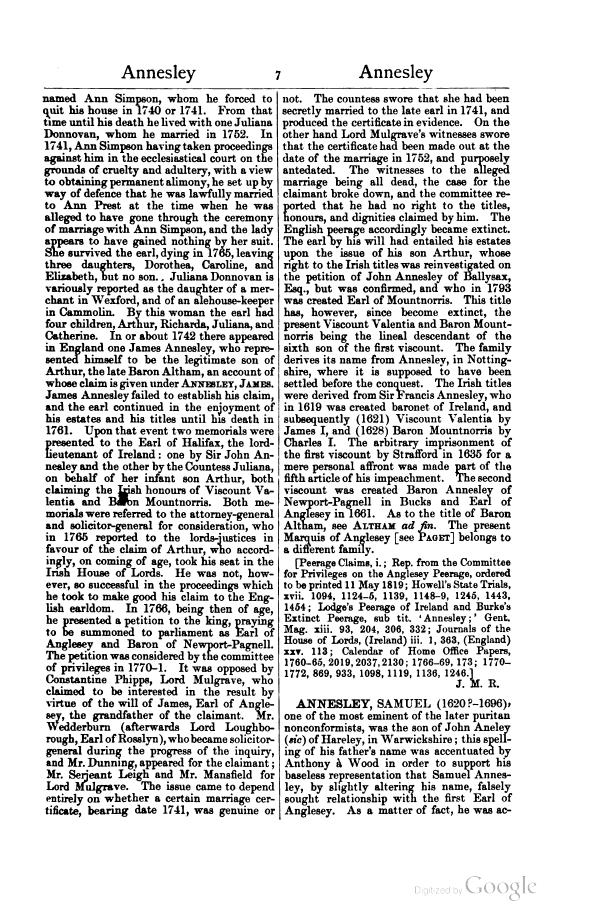named Ann Simpson, whom he forced to quit his house in 1740 or 1741. From that time until his death he lived with one Juliana Donnovan, whom he married in 1752. In 1741, Ann Simpson having taken proceedings against him in the ecclesiastical court on the grounds of cruelty and adultery, with a view to obtaining permanent alimony, he set up by way of defence that he was lawfully married to Ann Prest at the time when he was alleged to have gone through the ceremony of marriage with Ann Simpson, and the lady appears to have gained nothing by her suit. She survived the earl, dying in 1765, leaving three daughters, Dorothea, Caroline, and Elizabeth, but no son. Juliana Donnovan is variously reported as the daughter of a merchant in Wexford, and of an alehouse-keeper in Cammolin. By this woman the earl had four children, Arthur, Richarda, Juliana, and Catherine. In or about 1742 there appeared in England one James Annesley, who represented himself to be the legitimate son of Arthur, the late Baron Altham, an account of whose claim is given under Annesley, James. James Annesley failed to establish his claim, and the earl continued in the enjoyment of his estates and his titles until his death in 1761. Upon that event two memorials were presented to the Earl of Halifax, the lord-lieutenant of Ireland: one by Sir John Annesley and the other by the Countess Juliana, on behalf of her infant son Arthur, both claiming the Irish honours of Viscount Valentia and Baron Mountnorris. Both memorials were referred to the attorney-general and solicitor-general for consideration, who in 1765 reported to the lords-justices in favour of the claim of Arthur, who accordingly, on coming of age, took his seat in the Irish House of Lords. He was not, however, so successful in the proceedings which he took to make good his claim to the English earldom. In 1766, being then of age, he presented a petition to the king, praying to be summoned to parliament as Earl of Anglesey and Baron of Newport-Pagnell. The petition was considered by the committee of privileges in 1770–1. It was opposed by Constantine Phipps, Lord Mulgrave, who claimed to be interested in the result by virtue of the will of James, Earl of Anglesey, the grandfather of the claimant. Mr. Wedderburn (afterwards Lord Loughborough, Earl of Rosslyn), who became solicitor-general during the progress of the inquiry, and Mr. Dunning, appeared for the claimant; Mr. Serjeant Leigh and Mr. Mansfield for Lord Mulgrave. The issue came to depend entirely on whether a certain marriage certificate, bearing date 1741, was genuine or not. The countess swore that she had been secretly married to the late earl in 1741, and produced the certificate in evidence. On the other hand Lord Mulgrave's witnesses swore that the certificate had been made out at the date of the marriage in 1752, and purposely antedated. The witnesses to the alleged marriage being all dead, the case for the claimant broke down, and the committee reported that he had no right to the titles, honours, and dignities claimed by him. The English peerage accordingly became extinct. The earl by his will had entailed his estates upon the issue of his son Arthur, whose right to the Irish titles was reinvestigated on the petition of John Annesley of Ballysax, Esq., but was confirmed, and who in 1793 was created Earl of Mountnorris. This title has, however, since become extinct, the present Viscount Valentia and Baron Mountnorris being the lineal descendant of the sixth son of the first viscount. The family derives its name from Annesley, in Nottingshire, where it is supposed to have been settled before the conquest. The Irish titles were derived from Sir Francis Annesley, who in 1619 was created baronet of Ireland, and subsequently (1621) Viscount Valentia by James I, and (1628) Baron Mountnorris by Charles I. The arbitrary imprisonment of the first viscount by Strafford in 1635 for a mere personal affront was made part of the fifth article of his impeachment. The second viscount was created Baron Annesley of Newport-Pagnell in Bucks and Earl of Anglesey in 1661. As to the title of Baron Altham, see Altham ad fin. The present Marquis of Anglesey [see Paget] belongs to a different family.
[Peerage Claims, i.; Rep. from the Committee for Privileges on the Anglesey Peerage, ordered to be printed 11 May 1819; Howell's State Trials, xvii. 1094, 1124–5, 1139, 1148–9, 1245, 1443, 1454; Lodge's Peerage of Ireland and Burke's Extinct Peerage, sub tit. ‘Annesley;’ Gent. Mag. xiii. 93, 204, 306, 332; Journals of the House of Lords, (Ireland) iii. 1, 363, (England) xxv. 113; Calendar of Home Office Papers, 1760–65, 2019, 2037, 2130; 1766–69, 173; 1770–1772, 869, 933, 1098, 1119, 1136, 1246.]
ANNESLEY, SAMUEL (1620?–1696), one of the most eminent of the later puritan nonconformists, was the son of John Aneley (sic) of Hareley, in Warwickshire; this spelling of his father's name was accentuated by Anthony à Wood in order to support his baseless representation that Samuel Annesley, by slightly altering his name, falsely sought relationship with the first Earl of Anglesey. As a matter of fact, he was ac-
